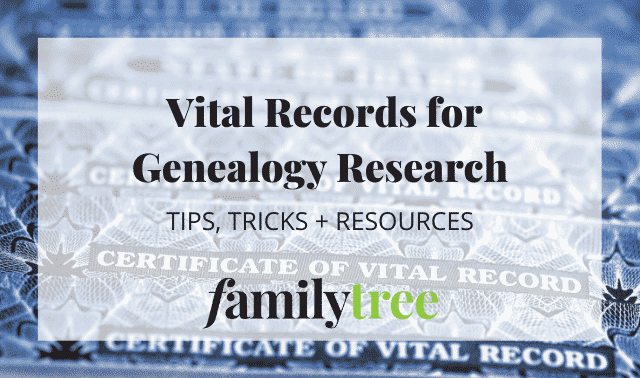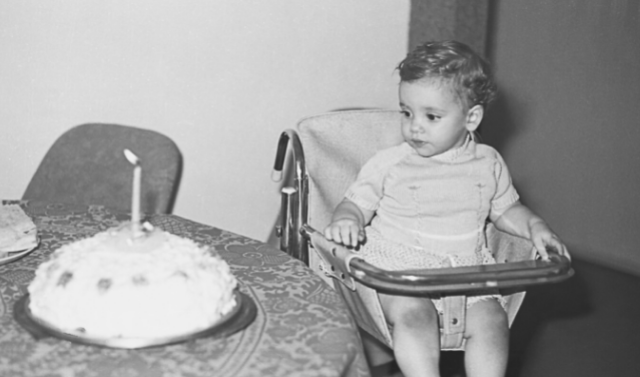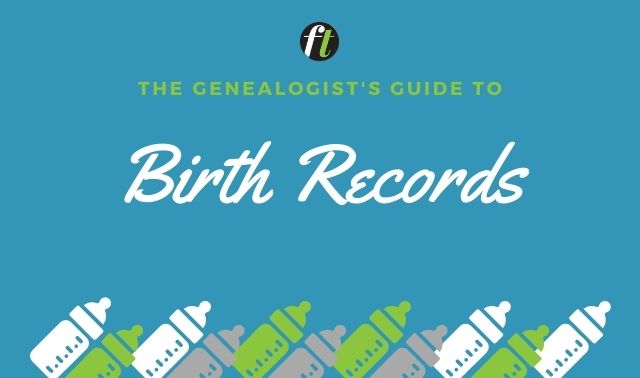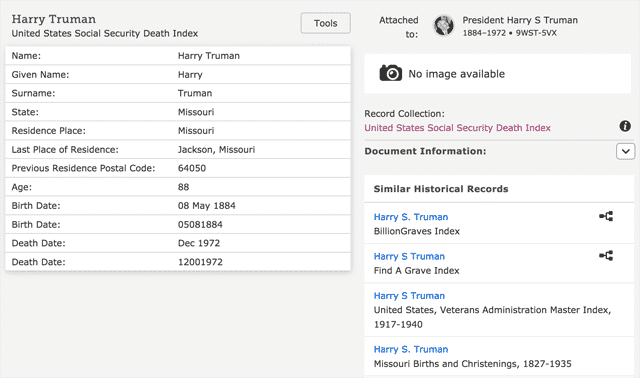Sign up for the Family Tree Newsletter! Plus, you’ll receive our 10 Essential Genealogy Research Forms PDF as a special thank you.
Get Your Free Genealogy Forms
"*" indicates required fields

Jump to:
Q: It seems that my great-grandmother is still living. (She was born about 1863!) I can’t find where she died and is buried. I know about where and when.
Q: What are coroners’ records? How can I find them?
Q: How can I access information from a funeral home listing on a relative who resided in California and died in the area?
Q: My great-grandmother’s death certificate gives her father’s name incorrectly, and the mother’s name is blank. The birth year is even different from what’s in her obituary and on her gravestone.
Q: My great-grandparents Minnie and Meyer Gilbert had a child in South Bend, Ind., in 1895. I have a copy of the birth record, but it doesn’t give the name.
Q: My great-grandfather’s 1939 South Carolina death certificate lists “code 946” as a cause of death. A state official told me the key to these codes is lost. How can I find out why my relative died?
Q: I need to find the place (probably in Virginia) and date of death of my ancestor Zephaniah Dyson’s wife. He remarried in 1811, but I can’t find anything on the death of his first wife, Dorotha (or Dorothy) Veirs Dyson.
Related Reads
Q: It seems that my great-grandmother is still living. (She was born about 1863!) I can’t find where she died and is buried. I know about where and when.
I’ve heard from family she was cremated and buried with her husband. I’ve searched the Internet, and all I’ve been able to come up with is her name on the 1910, 1920 and 1930 censuses. She’s listed below her husband in the 1910 and 1920 censuses, and as widow in 1930. I’ve even tried to search her by her maiden name and still come up with no matches. Any ideas?
A: If you’ve done all your searching online thus far, don’t worry about being stuck: You still have plenty more avenues to explore.
If your great-grandmother had a Social Security number, she may appear in the Social Security Death Index, or SSDI (search multiple versions of this database simultaneously from Steve Morse’s One-Step site). The SSDI lists the deceased’s last residence. Whether or not she’s in the SSDI (the index was computerized in 1962, so most deaths it contains occurred after that), though, if she had a Social Security Number, you can request her SS-5, or Social Security application, from the Social Security Administration.
Check Great-grandma’s hometown newspapers for obituaries and death notices in the time frame you believe she died. You can identify newspapers published during that time, and which institutions have them on microfilm, at Chronicling America. Remember that she may have remarried and changed her last name, so look for marriage announcements, too.
Try to request a death certificate from the vital-records office of the state where you think she died. This may be the state where you last have a record of her, or a state where one of her children lived. Every US state was issuing vital records by the 1920s, so you wouldn’t need to know the specific town or county to get the record. See the National Center for Health Statistics’ Where to Write for Vital Records website to learn the address, fees and ordering information for each US state. Research the husband, too. You know from your census research he died between 1920 and 1930, and you have a good guess where he died, based on where the couple lived in the census. Check newspapers for his obituaries, too. By identifying the husband’s burial location, you can find out if husband and wife are indeed buried together. Finally, also research her children, siblings and other family members. You may find a reference to her death in the records of one of her relatives.
Answer provided by David Fryxell
Q: What are coroners’ records? How can I find them?
A: English common law required that coroners in the United Kingdom and the American colonies investigate suspicious deaths. Records of their investigations exist from as early as the 1600s. In the 19th and 20th centuries in some US jurisdictions, medical examiners replaced coroners.
Not every death warranted investigation by a coroner or medical examiner, but you might find files on ancestors who perished in accidents, suicides or crimes. These files might prove scant or cryptic, or could include photos, depositions and the sort of evidence you’d expect on an episode of “CSI.”
Places to inquire after such records, besides the coroner’s or medical examiner’s office in the county where the death occurred, include the county clerk’s office, probate files for the deceased’s estate, and justice of the peace files. The oldest records may have been transferred to a state archive or library or university repository. (For example, the University of Pittsburgh has Allegheny County coroner files from 1887 to 1973.) These files may be restricted to members of the deceased’s immediate family.
The Family History Library has a few microfilmed coroners’ records and indexes, which you can find with a keyword search for coroner. Some county USGenWeb sites have transcriptions or summaries of local coroners’ records, as does the San Francisco Genealogy site. Because coroners’ records are an English legal tradition, they can provide clues about UK ancestors. Click here to learn more.
Answer provided by David Fryxell
A version of this article appeared in the October/November 2013 issue of Family Tree Magazine.
Q: How can I access information from a funeral home listing on a relative who resided in California and died in the area?
A: First, try to obtain your relative’s death certificate from the California state vital records office. Check to see if the newspapers carried an obituary. Either of these sources should give the name of the funeral home.
While most funeral homes have no problem accommodating genealogists in their requests for relatives’ records, keep in mind that funeral home records are private records, and the funeral home is within its rights to restrict or deny access. Also because funeral home records are private records, the content varies from one funeral home to another and from one time period to another.
To locate the funeral home, try searching for it online using your favorite search engine or a directory site such as FuneralHomesDirectory.com. Or use the following reference guides to help you locate funeral homes: American Blue Book of Funeral Service (Kates-Boylston), The National Yellow Book of Funeral Directors (Nomis) and The Redbook (National Directory of Morticians). One of these directories should be available in your public library’s reference section. If the funeral home is no longer in business, online research may reveal it was bought by another home—possibly, along with its records. You also could check old city directories to see if funeral home of a different name suddenly pops up at the same address as the home that handled your ancestor’s arrangements. If you can’t track down what happened to the home, the local historical society or library may be able to help. These organizations sometimes have old records of local businesses such as funeral homes, too.
Answer provided by Sharon DeBartolo Carmack
Q: My great-grandmother’s death certificate gives her father’s name incorrectly, and the mother’s name is blank. The birth year is even different from what’s in her obituary and on her gravestone.
I have proof of the correct names through my genealogy searches. How can I get this corrected, so that later generations would have the correct information?
A: There’s no way to change information on official records such as birth and death certificates, census records and passenger lists. The information on those documents is exactly what your ancestor reported and what the clerk (or whomever) heard—it’s part of the historical record. And who’s to say those other records you’ve found aren’t wrong? Our ancestors often spelled their own names differently at different times and didn’t always remember their own birthdays. Just note the different information—and what you believe to be “right”—in your genealogy software and on your research forms.
(Occasionally, indexers make mistakes when they look at records to create databases such those online at Ancestry.com. You may be able to alert the index publisher about an error—look for a Contact Us or Frequently Asked Questions page.)
In answer to a question you haven’t asked, this may not be your great-grandmother’s death certificate. Just as it is today, it was common in our ancestors’ time for unrelated individuals to share a name, even in the same community. Without a correct parent’s name and with the wrong birth year, the certificate may not give enough information for you to safely assume it’s your great-grandmother’s. Look for death information in other sources, such as funeral records and newspaper obituaries, to confirm her death date and other details.
Answer provided by Diane Haddad
Q: My great-grandparents Minnie and Meyer Gilbert had a child in South Bend, Ind., in 1895. I have a copy of the birth record, but it doesn’t give the name.
They had five other children, the next of whom, Phillip, was born in 1898 and died in 1907. The 1900 census lists the family in Toledo, Ohio, with Phillip, but not this first child. I conclude the first child died prior to the 1900 census, but I’ve been unsuccessful in finding a record of his death. I’ve searched death indexes, obituaries and cemeteries. What other resources are available for death information about an infant?
A: This may sound basic, but make sure the death indexes you’re searching cover the years you need, and that you’ve searched on spelling variations of the family name.
You’ve done well to come up with a theory—that the Gilberts’ first child died—and to research this theory in all the records you can think of. Since you haven’t uncovered any evidence to support that theory, explore other possibilities:
Just because a child isn’t listed in the census, doesn’t mean he died. More often than we’d like to think, a neighbor would guess at the names and ages if the family wasn’t home when the census taker stopped by. Research later records on all the family members for clues to the missing one.
Perhaps the first child and Philip are one in the same. Take a look at the birth record alongside whatever record leads you to conclude Philip was born in 1898: An 8 and a 5 can look similar. There could be a mistake on the first child’s birth record or on Philip’s (or both), particularly if your information comes from a transcription rather than an actual record. I’ve found my grandfather’s birth year as 1901, 1902 and 1913 in census records, a baptismal record and on his own resume.
Assuming the first child isn’t Philip, the baby may have been stillborn or died shortly after birth (especially considering that the birth record you have lacks a name). Check with the St. Joseph County Health Department for a stillbirth or death certificate. Realize indexes miss some births and deaths.
If a child died, your ancestors’ parish priest may have recorded the information. Look for nearby churches they may have attended, then contact the church (or the diocese, if the church is no longer there) to ask what records are available. The Family History Library (FHL) has some church records, too.
City directories, similar to today’s telephone books, may list members of a household, letting you trace the family between censuses. The FHL has South Bend directories for some years around the turn of the century. Its Toledo directories cover the 1890s and 1900s. To find these listings, run a Place search of the online catalog on the city name and look for the Directories topic. County histories also may give clues to epidemics and other events that may have caused the child’s death.
Answer provided by Diane Haddad
Q: My great-grandfather’s 1939 South Carolina death certificate lists “code 946” as a cause of death. A state official told me the key to these codes is lost. How can I find out why my relative died?
A: It’s possible to learn your ancestor’s cause of death without that code, or even if no death certificate exists. First, check his local newspaper for an obituary or death notice, which could’ve been published up to several weeks after he died. The library or historical society in his town may have an obituary lookup service. See here for South Carolina libraries’ contact information. In other states, use www.publiclibraries.com. For rural relatives, try libraries in nearby towns, especially county seats.
You might find an obituary in places where the ancestor previously lived or where relatives lived at his time of death. One of my ancestors lived and died in Charleston, SC, but her obituary was published in New Orleans, where her son lived. You’ll find some obituaries on USGenWeb sites, accessible from, and on sites listed at cyndislist.com/obits.htm.
Family letters and documents also may provide cause-of-death clues. Ask relatives, even if they were children when your ancestor died. Local historians and elders are good sources, too. If your ancestor belonged to a religious, social, fraternal or business organization, its records or newsletter may mention his death. Did any current members know him? Many such groups have Web sites with contact details. Also look for probate files, court indexes and coroner’s reports. For help finding and using court records, see my book The Genealogist’s Companion and Sourcebook (Betterway Books) and Courthouse Research for Family Historians by Christine Rose (CR Publications).
Answer provided by Emily Ann Croom
A version of this article appeared in the February 2007 issue of Family Tree Magazine.
Q: I need to find the place (probably in Virginia) and date of death of my ancestor Zephaniah Dyson’s wife. He remarried in 1811, but I can’t find anything on the death of his first wife, Dorotha (or Dorothy) Veirs Dyson.
A: This is long before the start of vital records in Virginia or neighboring states, so you’ll have to do some detective work—and get lucky. Dorotha/Dorothy’s place of death may have been near where her last child was born (assuming she had children) or where Zephaniah remarried. A good place to start is the family’s church, which may have recorded the first wife’s death or burial (though the family might have moved and switched churches). Look for cemetery records and check the church where Zephaniah remarried for any proof of his first wife’s death that he may have filed in order to take a new wife. If Zephaniah left land records, they may contain his first wife’s release of dower—or a reason, such as her death, why there wasn’t one. Try tracking down Zephaniah’s estate papers, even if they were probated long after his first wife’s death. Dorotha/Dorothy’s death may be recorded there. Also research her children’s lines forward for mentions of her in descendants’ records. Look, too, for family Bibles. The Library of Virginia has a collection of old family Bibles, many of them digitized. Given the time frame, Zephaniah or a close relative may have served in the Revolutionary War. If you can find a connection in the Daughters of the American Revolution’s (DAR) Genealogical Research System, you can write away for the documentation used to establish that genealogical line. This packet might include a record—such as church, court or family Bible documents—that would clear up your mystery. Go to dar.org and click on DAR Library, then Online Research, then DAR Genealogical Research System.
Answer provided by David Fryxell
A version of this article appeared in the December 2010 issue of Family Tree Magazine.









